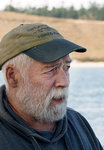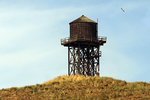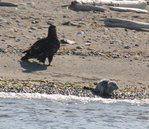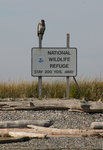For the past 33 years, Protection Island has been for the birds. For that reason, it's also been off limits to human visitors, shrouding the island and its resident wildlife in an air of mystery that …
This item is available in full to subscribers.
We have recently launched a new and improved website. To continue reading, you will need to either log into your subscriber account, or purchase a new subscription.
If you had an active account on our previous website, then you have an account here. Simply reset your password to regain access to your account.
If you did not have an account on our previous website, but are a current print subscriber, click here to set up your website account.
Otherwise, click here to view your options for subscribing.
* Having trouble? Call our circulation department at 360-385-2900, or email our support.
Please log in to continue |
|








For the past 33 years, Protection Island has been for the birds. For that reason, it's also been off limits to human visitors, shrouding the island and its resident wildlife in an air of mystery that continues to fascinate locals and tourists alike.
For the past 21 years, Chimacum naturalist Roger Risley, 66, has been a fixture of cruises around the island as a volunteer with the Port Townsend Marine Science Center, sharing his observations and insights with passengers who peer into binoculars from at least 200 yards away hoping to glimpse a tufted puffin, a rhinoceros auklet or maybe an elephant seal molting on the beach.
“I’ve been doing this long enough to see a lot of changes,” Risley said from his home nestled in the woods near Anderson Lake. “The natural environment out there is incredibly dynamic. That wasn’t obvious to me in 1994, but it is in retrospect. It’s been interesting to get a feel for the demographic sloshing back and forth that goes on out there.”
On Oct. 15, 1982, wildlife advocate Eleanor Stopps of Port Ludlow succeeded in having President Ronald Reagan designate the island a National Wildlife Refuge. At the time, it was estimated some 70 percent of the Salish Sea's breeding seabird population nested on the 364-acre, 220-foot-tall island located 5 miles west of Port Townsend at the mouth of Discovery Bay.
It's home to the largest nesting colony of rhinoceros auklets in the world, as well as the last two nesting colonies of tufted puffins in the Puget Sound area.
Of more than 80 bird species that use the island in some way throughout the year, several are most notable, including the auklet, puffin, pigeon guillemot, glaucous-winged gull, and pelagic and double-crested cormorants. It's also used by hundreds of harbor and elephant seals.
OBSERVATIONS
Though he's loved watching and listening to birds since a boy, Risley said his interests in the natural world have expanded, especially since he began volunteering on nature cruises.
He still obliges the many birders on cruises to the island, but prefers to tell people about its history, its geology and its land features to paint a more complete picture. He would rather talk about sand than pigeon guillemots, he said.
“I tell people it’s one-fifth of its original size and will likely be gone within 800 years,” Risley said, citing sea-level rise as the main culprit in the island's erosion since the retreat of the Cordilleran Ice Sheet roughly 13,000 years ago.
Its only potential savior: a fast-growing Dungeness Spit, he said. That spit currently protects the island from ocean swells and could possibly grow to envelop it in the next 500 years or so.
The island itself boasts two spits, created by its own erosion: Violet Point on the southwest side and Kanem Point on the east side, the latter of which is shrinking while the former is growing.
In fact, pilings are all that remain of a dock built by 1867 off Kanem Point by European settlers that arrived in the 1850s.
Risley also likes to point out that two rain-fed water tables perched in the island leak from its steep, exposed northwest-facing cliff.
“There aren’t many places where we get a cross-section of hydrology like that,” he said.
Otherwise, the island is rather dry. Risley said fog accumulation likely accounts for 40 percent of the island's water budget, estimating it gets about seven inches of rain annually. That fog collects along the water side of the island's mostly Douglas fir forest, situated on the north and northeast ends of the plateau.
PUFFINS RELOCATING
When it comes to birds, Risley said he prefers to point out what he's seeing more of, such as the ancient murrelet and the Caspian tern.
Many are eager to spot a puffin, though they've been in decline in the state for decades, and on the island as well.
“This is the first year we’ve gone out and not been able to see puffins,” Risley said, noting they are considered a species of concern for the U.S. Fish and Wildlife Service. “People freak out thinking the puffins are dying. They’re not; they’re just moving their nesting areas to appropriate areas. On the whole, there’s 2.5 million of them and ours are just moving north.”
Humpback whales are showing up more often in the Strait of Juan de Fuca, he said, though gray whales don't seem to come around anymore, possibly due to a decline in forage fish such as herring.
Eagles and elephant seals have emerged in strong numbers, he said.
“Marine birds are all in decline as the marine environment is in decline, but the eagle and the elephant seal have probably undergone the biggest changes out there since I’ve been visiting.”
In 1997, the island became the first spot in the state to host a breeding pair of northern elephant seals, though Risley said he'd seen them hauling out on the island as early as 1983.
The bald eagle was added to the federal Endangered Species list in 1978, though a few were known to be living on the island. Its population increased dramatically before it was removed from the list in 2007.
“When I first moved here, I thought Eaglemount was a joke,” Risley said of the ridge at the head of Discovery Bay. “I thought there were no eagles out here. When I used to go out there [to the island], I’d be lucky to see a couple of eagles, back in the bad old days of DDT. Now, as many as 50 eagles have been seen out there at once.”
Risley said more eagles means more predation on other animals, including the glaucous-winged gull, which is the most common gull in the state.
GULL COLONY
The island's gull colony is considered one of the largest in the state, though in the early 2000s it declined to about half its 1993 size of 5,200, according to a 2012 article in Northwestern Naturalist by biologists David Cowles, Joseph Galusha and James Hayward.
They suggest a combination of eagle predation and an expansion of tall grass on Violet Point, where gulls nest, has forced the gulls to find new territory, though mostly still on the island.
“I think they [the eagles] take a certain percentage of the gull population and make it harder for them to have breeding success,” Risley said.
In the mid-1980s, gulls began nesting on flat roofs in towns around the Puget Sound, such as Port Townsend, Risley said.
“They are eagle-free areas and they are predator-free because there are no dogs or cats or raccoons,” Risley said, recalling that the island is the only place gulls were nesting when he arrived on the Olympic Peninsula. “Eagles don’t like to be around buildings very much. They tend to stay up on a bluff in a tree or on the clock tower. They’re wary. They’ve been shot at. The gulls' previous breeding grounds had to have been filled to capacity or somehow no longer suitable, so they might have been looking for more room to nest or eagles might have driven them out.”
Also, in the late 1980s, Jefferson County stopped dumping its garbage in open pits at the landfill on Jacob Miller Road, he said, putting hungry gulls out of business and possibly causing them to move elsewhere.
Risley's advice for keeping gulls from nesting on downtown roofs: a four-foot-high grid of berry wire covering the area of the roof.
“If you get enough on there, the gulls won’t fly under it,” he said. “They're ground nesting birds that spend their whole lives out in the open and don't feel comfortable flying under things like telephone wires, for example.”
MIGRATING WEST
Risley began his relationship with the island in 1970 upon moving west from his urban hometown of Buffalo, New York, in search of the wild, natural world that had been calling to him as a child.
“The birds in my neighborhood were the only wild things,” he said. “It was a bad neighborhood, but I could see there was a wilderness on my doorstep. I’d go down to the river and fish a lot. Once I learned to catch fish, I was already sampling my environment. I was always getting my dad to take me someplace and he would just sit in the car and read and I’d go out and fish or hike around.”
At 12, Risley lied about his age to get into Sea Scouts. Years later he won a Columbia Press Society award for poetry while studying English at the State University of New York at Buffalo, but he had also begun jumping into boxcars headed for Seattle each summer to do commercial fishing.
“All you needed was a bottle of water and a sleeping bag,” he said. “It was a very Kerouac-thing to do.”
In 1970 after a few seasons of fishing in the Puget Sound, Risley was headed back for his final year of school.
“I realized I didn’t want to live in an artificial environment anymore,” he said. “So I decided not to go back and I’ve just stayed here ever since.”
Risley spent the next 23 years living off Woodman Road on Discovery Bay before building his home near Anderson Lake. In the 1970s, Risley worked in the woods with cooperatives, planting trees and thinning commercial forests.
“I was outside all the time,” he said. “I spent a whole winter at Satsop Lakes in a tent. I was pretty familiar with plants and animals and birds because I was out in it all the time.”
In those years, Protection Island was for sale, or at least hundreds of lots were being platted for future summer vacation homes. It was also open to anyone who could reach it by boat.
“I used to paddle out in my canoe and take my fishing pole and a bucket and some rock salt in case I caught too much fish to eat while camping for a couple days,” he said, recalling the sound of auklets returning to their in-ground burrows. “When it got dark, you could hear hundreds of them plopping down around you.”
PLATEAU PRAIRIE
Some 70 years after George Vancouver gave Protection Island its name in 1792, settlers began farming the plateau, even digging a well. The plateau's prairie land eventually turned to hardpan and resident farming ended by 1928, though mainland farmers continued growing crops into the 1950s.
The island was used by the military in World War II. Prior to the war, a man introduced pheasants to the island in order to study them and, in the 1950s, hundreds of sheep grazed the plateau.
In 1968, the island was subdivided into more than a thousand lots; roads were built, water pipes were laid and a tower was built, an airstrip was created and a marina was dug at Violet Point.
“I guess it was going to be a kerosene lamp and candlelight subdivision,” said Risley, questioning how electric power would have been extended to the island. “It was pretty impractical.”
By the mid-1970s, construction stopped with concerns over the lack of water on the island and the potential impact to nesting seabirds.
At the same time, the state created the Zella M. Schultz Seabird Sanctuary out of 48 acres of the island's westside, including Kanem Point and the northwestern bluffs.
Risley said he recalls seeing peacocks on the island in those years. He also recalls seeing deer swimming between Cape George and the island.
“When I lived down in Discovery Bay, they used to swim back and forth,” he said.
Deer reportedly showed up on the island later in the 1990s and grew to a herd of as many as 80, he said.
NATURAL WORLD
In the 1980s, Risley worked for the county's Parks and Recreation Department, then in the early 1990s he worked with the state Department of Fish and Wildlife doing test fisheries, harvest surveys and shrimp counts, putting him on the island at least 50 times a year.
He spent a few years in the late 1990s horse logging on Indian Island and teaching a Peninsula College class on marine birds and mammals.
“I spent all my time studying birds back then, doing little studies, capturing and weighing birds, building nest boxes for pigeon guillemots under the marine science center,” said Risley, who had never finished his college degree. “They all assumed I had a college degree, so I figured I better go get one real quick.”
He graduated from Western Washington University with an Environmental Policy degree in 2001 and jumped into an internship with the U.S. Forest Service doing bird surveys in the peninsula's old growth forests. He also surveyed fungus, bats, trees and more, always on the move, camping in the forest.
“I’ve kind of pieced together a life by following my interests,” he said. “I have just done whatever it takes to live here on my own terms.”
For Risley, being a naturalist comes naturally.
“I’m not a scientist,” he said. “I’m not digging up a lot of data; I don’t even keep a journal. But everything you see out there presents a dozen questions.”
After 45 years watching the island and its wildlife, he's still asking questions. For example, he'd like to know more about the island's microclimate and its forest.
“A remote-operated weather station out there would be awesome,” he said.
Risley said he hopes to gather a team to survey that forest.
“Before I die I need to get out there and get some data on that forest,” he said. “I have to get off my butt and get a proposal into fish and wildlife. I have a lot of questions.”
Risley said he expects his relationship with the island and its wildlife to continue for years to come, as well as his participation on nature cruises.
“I always wanted to expose myself to the natural world and live in a place like this, where I can have a big garden and fruit trees and live among wild animals,” he said. “I guess I succeeded.”